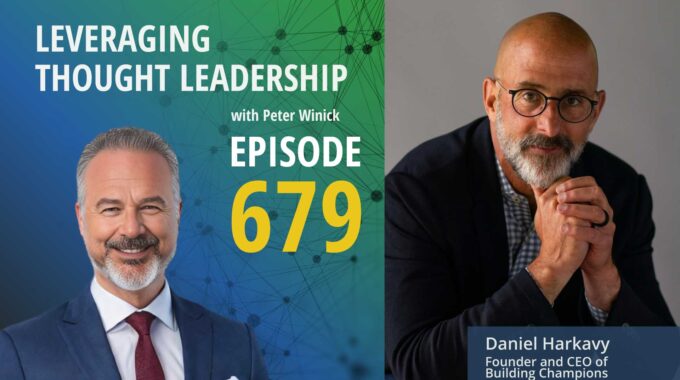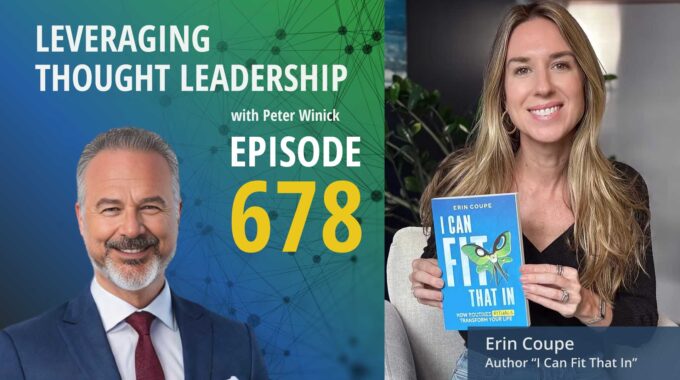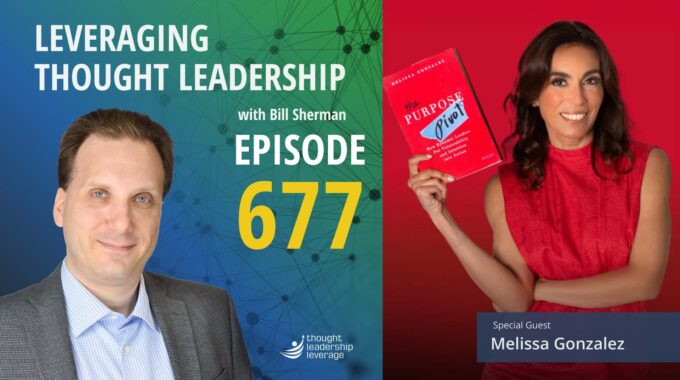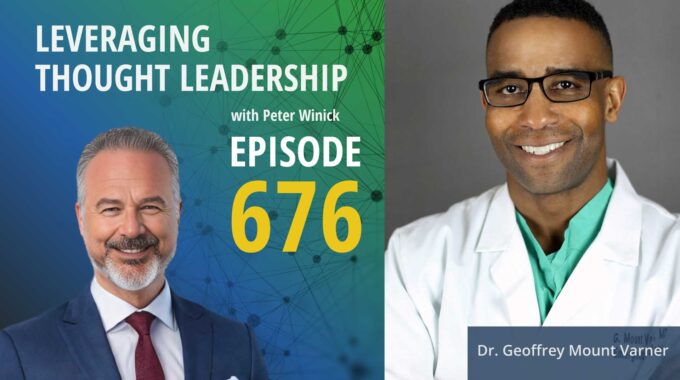A roadmap for leaders who want to multiply their impact — not their workload. This…
The Power of Peer-to-Peer Leadership | Ken Banta
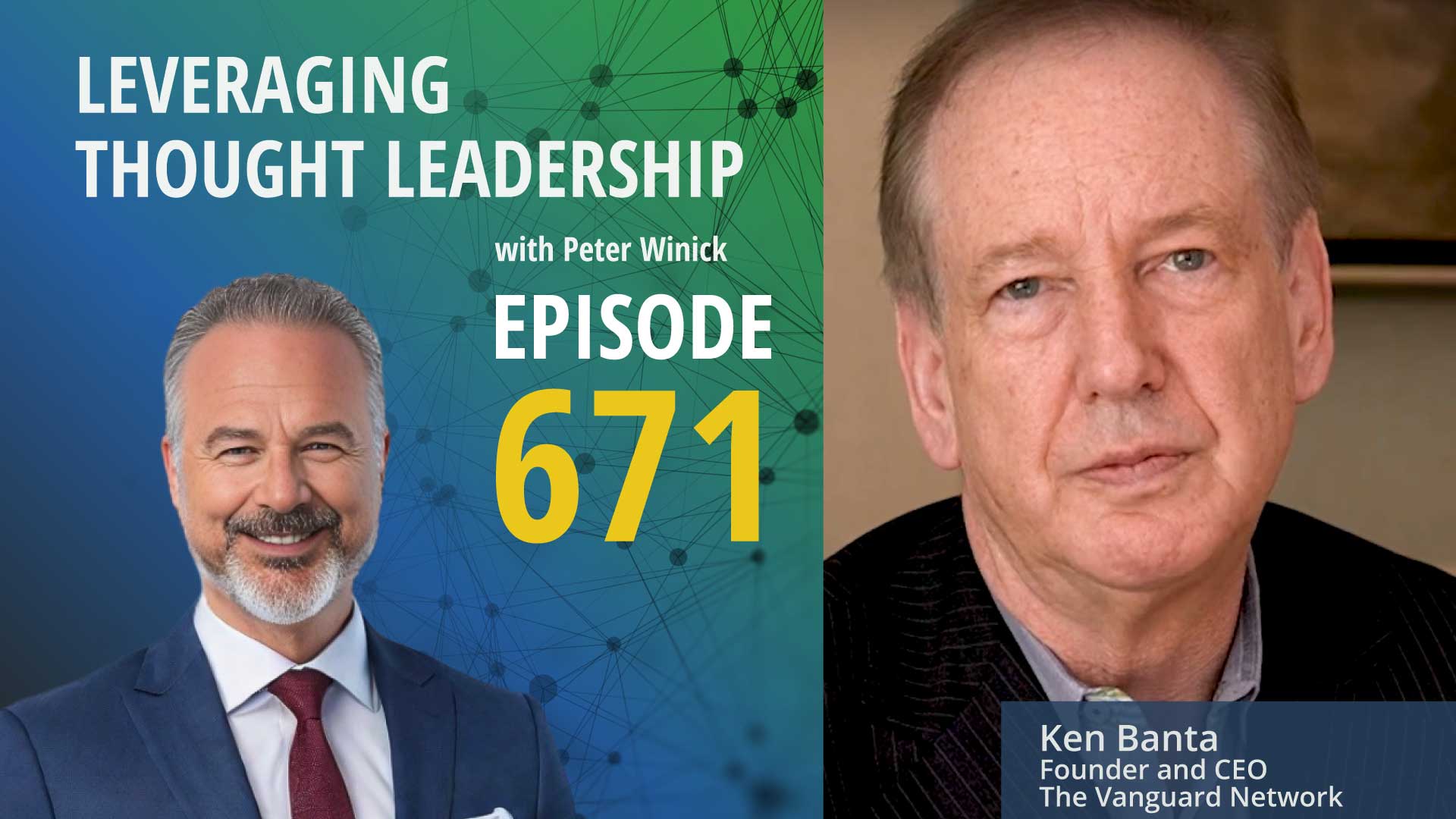
Turning Conversations into Influence
This episode highlights how peer-to-peer networks drive candid dialogue, spark fresh insights, and build stronger executive presence. It shows how real conversations create practical strategies, trusted connections, and lasting value.
What happens when senior executives step into a room and speak with radical candor?
In this episode of Leveraging Thought Leadership, host Peter Winick sits down with Ken Banta, Founder and CEO of the Vanguard Network, to explore how real leaders grow stronger through dialogue—not monologues.
Ken doesn’t just advise on leadership—he builds ecosystems where executives learn directly from each other. The Vanguard Network creates peer-to-peer forums where GCs, CEOs, and senior leaders share their toughest challenges and unfiltered lessons. The power comes not from lectures or PowerPoint, but from raw, honest conversation.
Members of his network walk away with two powerful outcomes. First, practical insights they can use immediately—solutions drawn from peers who’ve been there before. Second, the relief of knowing they’re not alone. When a board chair demands instant answers, having the confidence that others face the same issues is invaluable. These conversations create resilience, credibility, and a stronger sense of leadership presence.
Ken also shows how these networks spark new thought leadership. Dialogue around real problems fuels fresh ideas, posts, and even books like his “Seeing Around Corners”. This isn’t theory—it’s leadership in action, captured and shared for broader impact.
The results are tangible. Leaders leave with new strategies, new allies, and sometimes even new career opportunities. One member walked peers through a cyberattack disaster, openly admitting mistakes and lessons. Another two struck a career-changing deal over dinner. This is thought leadership at its highest level—intimate, applied, and deeply human.
If you want to see how conversation transforms into influence, this episode is for you.
Three Key Takeaways
- Dialogue beats monologue. Executives gain more from candid peer conversations than from lectures or presentations.
- Leaders don’t stand alone. Sharing challenges in trusted forums provides reassurance and practical solutions.
- Conversations spark influence. Real stories and exchanges fuel new thought leadership, stronger presence, and fresh opportunities.
If you found Ken Banta’s episode insightful, you’ll want to keep the momentum going with Karen Leland’s conversation on the performance of thought leadership. Ken showed how peer-to-peer dialogue fuels fresh insights and builds executive presence. Karen takes it a step further, exploring how leaders can deliver their ideas with clarity, confidence, and authenticity so they truly land with an audience.
Together, these two episodes connect the what and the how of thought leadership: Ken highlights the power of conversations that spark ideas, while Karen shows you how to perform those ideas, so they inspire action. Listen to Karen’s episode to learn practical strategies for elevating your communication, amplifying your presence, and making your thought leadership unforgettable.
Transcript
Peter Winick And welcome, welcome, Welcome. This is Peter Winick. I’m the founder and CEO at thought leadership leverage, and you’re joining us on the podcast, which is leveraging thought leadership. Today, my guest is Ken Banta. Ken is he’s the founder, CEO of the Vanguard network and focuses on developing high-performance leaders, building high- performance organizations. And he’s an advisor leadership and executive teams, and he’s been involved in over 11 global mergers, which I’m sure that in and of itself is lots of stories in there, but, uh, welcome aboard today, Ken. How are you? Well, thanks, uh Peter. And thank you for having me. My pleasure. So how did, how did all this happen? You know, like how did. Tell me a little bit about your journey, your path. Vis-a-vis fall leadership.
Ken Banta Yeah, well, so I, um, I started out, um uh, actually, uh, doing graduate work at Oxford university, uh as a Rhodes scholar, as it happens. And from there I got recruited to work for the time magazine and I kind of serendipitously ended up covering Eastern Europe for them before. All the revolutions began. I think they thought they were sending me to a sort of quiet backwater and, um the minute I got there, it went crazy. And so I was really lucky to be part of a unique time in history. And I covered that for almost more than five years. Uh, then I was with them and then I went into consulting for a while in public affairs. Um, I’d say both those things kind of developed a sense of, um, being able to get to the heart of things fairly quickly to be able to analyze situations. I then got recruited into, um be the head of corporate affairs for what turned out to be a train wreck of a merger between pharmacy, a corporation of Sweden and company of the U S a big disaster. Happened to land with a really, uh, phenomenal CEO, uh Fred Hasson and really spent the next 15 years, I guess, practically working with him and a team of other people turning things around. And so those mergers, acquisitions, um, transformations that you mentioned were all on that watch. And I think, you know, the two big things that came out of that work, Peter, were first of all, uh an appreciation for what, you know, really good leadership can do. And also how to get change to happen in organizations. And obviously the two things are connected. And so that really led the way to a Vanguard, the group that we have today. Several of those people I worked with, including Fred had said, well, you know, you’ve had so much experience in this area, why don’t you consider putting it to work with others? And that’s really what we did from, uh, 2014 onward to today. Yeah. So in terms of the Vanguard network, it’s really a community. Is that a, is it a fair? Yeah, I think it’s, you know, what I think sets it apart from most conferences and other types of activities is it’s a membership organization and also it’s totally devoted to leadership. So it’s not about anything else, uh, which becomes more and more important the higher up you go. It’s somewhat of a neglected topic though. Everyone talks about it, but no one really gets deep into how you do it. And so our work is entirely focused on that. And it’s not, not really a didactic type of thing with lecturers and programs we have, uh, it’s really peer to peer. So we have something coming up on, on Monday with some of our network of G C O CEOs in the life sciences space, and, uh it’ll be six sessions of them really leading the discussion about what matters to them. Uh, we make it happen. Yeah. Hey, what is it? They’re it.
Peter Winick So stay there for a minute because what I’m thinking about as, as you’re talking is lots of thought leaders wonder, well, what is the mode? What’s a good modality? What’s the format? What’s good vehicle for my stuff? And there are the obvious answers. I should write a book. I should be a keynote or I could do a workshop. And I think that they often either aren’t aware of, or don’t think about, or whatever the power of using the core intellectual property, the thought leadership you have as the foundation of a peer to peer network. It’s not a new idea. Right. To do that. But I think people underestimate the value, you know, in terms of, you know, what are, what people looking for? There are times I want to be taught and I want to take in some information and say, okay, I got that. Check the box. Don’t really need so much more. But what I find in my experience is peer to peer groups, especially when they’re aligned to a certain type of thought leadership, really are there to support one here. The burden isn’t on Ken to say, Oh, I’ve got a meeting next week. What will I teach them? You’re, it’s a facilitated. Right. And there’s an expectation of the other members that they’re there to support one another and help one another. And all those sorts of things. Can you talk about some of the transformative experiences that some of the members have as a result of being in a group like this?
Ken Banta Yeah, absolutely. You know, so first of all, I think that’s exactly right. And I’d say that the feedback we get about the Vanguard network is that not only is it peer to peer, but it’s done in such a way that it is sort of genuinely a conversation among leaders and not a kind of peroration by somebody who pretends to be having a conversation, but it’s really about them. And, you know, we all know that type where the, you know, the question takes longer than the, uh, than the response. Because they have so much to say about it. So what we really do is make sure that the members are the ones who are the stars of the show. Some concrete things, you know, that come out of it. Uh, one of our, uh, GC leaders, a very, very impressive guy, multiple GC over multiple companies. I asked him that question. What do you get out of this? And he said, it’s really two things very often. One thing is the, um, that I learned something, you know, a new one or two new things from my peers, which he said. You know. By the time you’ve been doing what I’m doing for as long as I had to get even one new thing out of a week is remarkable. And he said, finding two in five hours with this organization is astonishing. And then the second thing he said is you really can’t underestimate how valuable it is for people in my position to have a recognition that others have the same problem I have, or they’re grabbed with, or they don’t have an answer to a certain thing. He said, you can’t, I can’t tell you how many times I go to in front of my board or to the CEO. And they’re saying, well, why, why can’t we solve that? Why, why isn’t there an instant answer? And he said, it’s incredibly valuable to be able to say on this particular one, Mr. Board chair, seven other GCs have the same problem we’re having here. So my feeling is that we don’t want to presume we know more than all of them. And so uses
Peter Winick Yeah. So they could be transparent and vulnerable because it’s probably not a good idea for a GC to be running around, you know, back at the office saying, I don’t know, I’m not sure I’ve seen that before. Like even if it’s true.
Ken Banta Yep. You know, maybe you don’t want to be out there on a limb on your own.
Peter Winick One of the other things I think is beneficial to these sort of communities, these peer to peer groups, these masterminds call them what you will. Is it also gives the thought leader consistent fodder for, uh, creating new thought leadership, like, wow, you might be like, you know, everybody’s AI today, so maybe GCs are having a struggle with how to deal with AI or whatever it is, it gives you a tap into what’s really going on in the real world today that you can think about and go, wow. Question that, you know, Sam asked last week, that’s really interesting. I’m going to write an article about that. Or it leads me to think about a different way to use my thought leadership. So I think it’s kind of a cool ecosystem there. Does that make sense?
Ken Banta Absolutely. And, you know, I use this ecosystem of people or leverage it myself in, uh, the things I post on LinkedIn. I just finished a book called, uh seeing around corners, which is a compendium of points of view from many of our members. Uh, but you know it’s kind of collated by me. So the implication, which are correct is that I chose them. I mean, these are not just random thoughts. These are thoughts that were really relevant. So it’s a kind of a second level thought leadership, uh if you like. And then, um, you know, we have a number of, uh, genuine sort of thought leadership types. You know, people who are expert in their realm, joining some of these meetings, but they join in a certain way. They never give a speech. They never gave a presentation. They’re there just like you, uh they may be sitting, uh near the front of the room to kind of start a conversation, but they don’t have a bunch of papers they’re reading from. They do not get to present PowerPoint slides. So it really changes the dynamic. They become part of the, part of the room. But they become the room that has a particular area of knowledge. And, um, I’ll give you one, one example. Um, Debovois and Plimpton are partners of ours. So they’re there on a regular basis. They’re never lecturing on anything. What they’re doing is they’re often giving a case study. They’re leading a discussion around a particular type of problem. And what I said to the group is that, you know, everyone in this room is probably an N of one on most problems, like a cyber attack or an AI problem or a CEO that went over, you know, went off the road. They’ve seen 10, 20, a hundred of those. And so when, uh, for example, Mark Goodman, the head of their healthcare practice, uh is talking about something he’s giving you the benefit of, you know, the 10, the 20, the 30 experiences, but he’s not doing it in a lecturing way. He’s doing it. In response to a question. Someone says to Mark, in your experience, uh what did you find was the biggest mistake people made in this particular situation of, for example. Maybe a big mistake with the FDA, serious error in judgment and how to approach the FDA possible ethical lapse and how they did things. He’d say, well, you know, I’ve seen about 10 or 15 of these. And so, uh, my feeling is, you know, the, the thing that I see happening again and again is, you know denial or a demand that the, you know, to correct the FDA. And he’s say, you know, that certain things work, certain things don’t. So that’s the kind of thing. He brings the party, but he’s not bringing it in to the party in a, in a lecturing sort of way. Isn’t it.
Peter Winick If you’re enjoying this episode of leveraging thought leadership, please make sure to subscribe. If you’d like to help spread the word about our podcast, please leave a five star review at rate this podcast.com forward slash L T L and share it with your friends. We’re available on Apple podcasts and on all major listening apps, as well as at thought leadership leverage.com. Forward slash podcast. So I will.
Peter Winick Test this idea that I’ve had with you, if I might. So I think again, I’m talking about sort of these peer to peer groups, these masterminds, et cetera, that there’s three primary value props that they offer to the peppers. Why am I spending my time in the firm’s money here? Yeah. Content. Right. That’s probably why I would justify it on a budget or if I had to justify it to my boss, there’s great information here. There’s great learning here, whatever. The next is community. Right. And I say, oh, and it’s a, uh, I’m getting this content in a community of nice or like-minded, but senior level folks that sit in my seat. Right. But the third, which is the value prop to the individual that they might not articulate to justify the investment is the connections, right? The connections that they’re making that will last beyond potentially the current role, friendships. I don’t want to call it networking. Cause I think that dilutes what it really is, but they, they have their own friendships. They can do business with, maybe they recruit one another. Maybe they get on each other’s boards, whatever it is. Is that a fair sort of recap this, this content and community and connections?
Ken Banta Yeah, I think that’s right. And, uh, it captures some of those things. I think I was describing, you know, uh values. Those are good buckets to put them in and they, you know, they’re Venn diagrams. So they all kind of come together because the one wouldn’t happen without the other and, uh no, one of them is sufficient perhaps, but all three make a really high, uh you know high value proposition because you know the main problem for, uh these people is time. Well, it’s not their main problem, but it’s their main limitation. The biggest problem is the problem, but they want to take it back in time. And so, uh, this is a, in some ways a very high return, high impact use of their, their time. Uh, and I do think that part of, uh call it a network or friendships or associations with people is, uh maybe the highest value piece. Although it’s probably not the one you put on the explanation of why they should fund it. Exactly. But, uh but it’s definitely valuable. And who knows, maybe some of them actually do put that down. I never see the, I never see the rationale of how they got this thing through accounting. But, you know, one aspect of that, a good example, a tangible example is that, one example is that a, um, a very, uh, senior GC of one of the big insurance companies actually spent an entire session at one of our forums a year ago, uh going through a blow-by-blow account of what happened in the cyber-attack they experienced. And she pulled no punches. It was, you know, here are the six mistakes I made. Here’s where the CEO let us all down. This is where my IT team didn’t really… You’re not going to read that in the journal, right? That’s not the… You’re going to not read it anywhere else, but it had, you know, 20 other GCs on the edge of their seats. And, uh, but in a very, you know, kind of conversational fashion, she wasn’t giving a speech about this. She was talking about it and various other GC’s were saying, so why did you think that was a mistake, that thing you did? And she said, well, I didn’t think it was at the time, obviously, but now I realized that it was and here’s why. And so it was that kind of dialog. And I can pretty surely say that… You know, most of the GCs in the room took away something about how they would handle something like that in the future that they didn’t know before. Another really funny back…
Peter Winick I want to stay on that for a bit because that’s probably, you know, that goes in the unknown, unknown, right? That’s probably not even a question that they knew they should ask of, right, if I have a cyber attack or when there’s a cyber attack on my entity, what are the three things I shouldn’t do? Whatever, right. Like it’s not something they’re thinking about. They’re thinking about what should they do or what can they do to prevent it or whatever. But hearing from someone that was sort of a victim of that and how they dealt with it and how they were transparent enough to say, hey, here’s, here’s what I would do definitely. Differently next time, or here’s what you should not do if you’re in that seat when that happens.
Ken Banta And also it was a study in what I would call executive presence as well, because this GC was so forthright, so sort of straightforward about this, that as you know, it takes a lot of self-awareness and capability to narrate a disaster scenario as if you were talking about the weather and, you know in a very, very open way. Another interesting one was two GCs were having dinner at one of our sessions after one of our sessions and… One of them was leaving his role and the other one, who’s a very storied GC had, I think at that point he had seven GC seats under his belt to talking about this move. And by the end of the evening, let’s call him Dave said to Jack, let’s go on Jack, Dave, maybe you’d be interested in this role then. And that would save us all a lot of trouble. And, and Dave said, well, you know, actually I think I might like to do that. And so I, they probably went through a lot of HR hoopla, but… Essentially, they cut that deal at dinner and that would never have happened without having gotten together in the kind of community that you’re describing.
Peter Winick Well, that’s because of the trust…That’s built, the rapport that’s built, et cetera, right? Where you take a deal to sort of third base after having made the investment of being in these groups together and sharing stories, whatever, you know, and getting to know one another. Any thoughts or advice that you would have for someone that’s thinking about diving into this world of Thal leadership, although it wasn’t necessarily your intent, that’s where you’ve landed. Any, any thoughts to others that are out there that are thinking about… How I might do this?
Ken Banta I think kind of leading in the direction you were indicating, Peter, that simply sort of didactic thought leadership is still there, but I don’t think it’s as telling as it could be, you know, getting on a, at a podium and telling a bunch of insiders what they should think about the future. But I think real thought leadership more and more is figuring out ways to create conversations and dialog among people and create networks or groups of like-minded people around that. It’s that sort of… I guess, you know, one way I think of it is, you know, there’s old fashioned leadership by command and control. And then there’s leadership which is through influence and persuasion. And so I think that thought leadership, you know, good thought leadership effective thought leadership today involve a certain amount of persuasion and leading from behind doing other things that are not in your face. And, you know, I, I think we do those things pretty well at Vanguard. You know, it’s not enough to just say, well, put a bunch of senior people in the room at small tables and magic will happen. It won’t.
Peter Winick It needs to be… You said… I love what you said about the dialog because I think there is a time and place for monolog, right? This is the world renowned expert on something, something, something, sit down, shut up, listen to what they have to say. That’s like, this is a moment in time where you’re going to have this person in the room. But for most of us, most of the time, dialog is a better means of communicating and learning and processing than… Monolog. And I think people don’t sort of understand that and think, well, I’m the expert. I always live in sort of this monolog I speak. And, you know, it was like the old EF Hutton commercials and everybody stops and listens. Not so much. And I, and I love your group is a group of really high level experienced top notch folks that in their own right, individually could be going out, doing monologs all the time, but get them in a room and they might all think they’re the smartest person in the room, but the end of the day, you want to be in a room with smart people.
Ken Banta Let’s just say you’re one of the smartest. And so the, but you know, I have in my own mind, what I call the, the iPhone quotient. And by that, I mean, it’s the percentage of time that people are not on their iPhone. And, you know I’m pretty pleased with what I see, you know, with our sessions and it’s nothing to do with me. It’s with the quality of the discussion that these individuals are having. But also it’s interesting, you know, there’s a lot of, there is a lot of pure, I wouldn’t call it pressure, pure leadership, right? If you’re sitting at a table with four other general councils and you’re on your iPhone. It really is sending a message that you don’t want to send about how important they are and whether you think they have anything useful to say, and I don’t want them doing that with you either. And so that’s the, that’s the sort of a stick aspect of it. The carrot part of it is that I think there’s a genuine feeling that, you know, actually that stuff can wait. This is really worthwhile, you know, as we all know, most of us go to conferences, unfortunately with a pretty bad attitude, which is, this is probably not going to be tremendously interesting. I’m going to, you know, look up from time to time and listen to what might be interesting, but I’ve got work to do here. And then you say social time for the water cooler and the drinks party. And, uh, the other five hours are kind of a limbo. And so we’re five hours of people off their iPhone.
Peter Winick Well, I love what you said earlier about, you know, the scarcest resource these, these folks have is time. So they’re giving up their time, but then underneath that, sometimes we think we’re giving our time, but we’re not really present. So I like that iPhone test of yeah, okay. I’ve carved out two hours of my day to be here, but dot, dot, I’m checking emails. I’m just, you know, all these other things to actually be in the moment and be present, particularly in a group of really smart people that I admire, that I respect, that I want to hear what they have to say. That’s the I don’t think there’s a better version of the standing applause or call it what you will, then you can give today.
Ken Banta Yeah. And that’s where, you know, looking back, I think perhaps the experience I had as a journalist with time comes into play in the sense that I have a pretty good a bullshit ometer. So I really, I kind of avoid or I discourage things that are really, if not stupid, at least time consuming or, you know, bravado type stuff. And also it’s not just me leading sessions, but we have a practice of leading these sessions in a very journalistic manner. So, you know, there’s nobody wind up. There’s a lot of provocative, but not nasty questions. And then we, you know, it’s very easy to end up in a dialog like you and me, perhaps at the front of the room, just talking away about what we’re interested in, but we have a practice of making sure that, you know, we look out in the room, we say, Lucy, that that looked like it was a really interesting point for you. Oh, I love that. I love it. You do need a certain kind of mindset to do that and to realize that you’re, if you do it in the right way, you’re not putting someone on the spot. You’re recognizing how interesting they are. And, uh, or we’ll say things like, you know, Peter, we’d like to come to you in about five minutes on this. Cause I sense that you really interested in it gives you a chance to collect your thoughts. You’re not a deer in the headlights. You were interested, but maybe you would feel a bit, a bit put upon if we just said, well, in short point of view. So there’s a, you know, I guess it’s the usual story. It’s like, you know, ballet is supposed to look very easy. Well, you know, we know that it’s not.
Peter Winick Exactly. Exactly. This has been great. I appreciate your time, Ken. And I thank you for spending some time with me today. That was terrific.
Ken Banta Thanks again, Peter.
Peter Winick To learn more about Thought Leadership Leverage, please visit our website at thoughtleadershipleverage.com. To reach me directly, feel free to email me at peter at thoughtleadershipleverage.com, and please subscribe to Leveraging Thought Leadership on iTunes or your favorite podcast app to get your weekly episode automatically.


